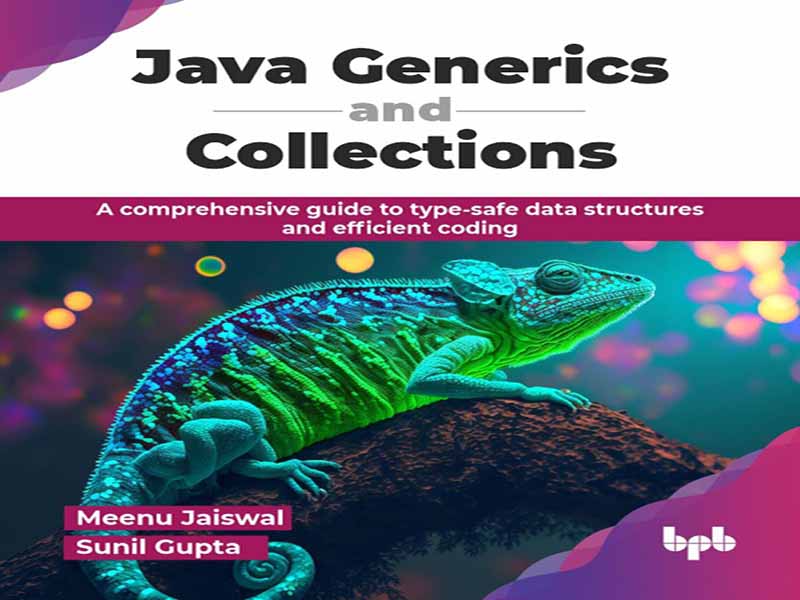- عنوان کتاب: Java Generics and Collections
- نویسنده: Meenu Jaiswal Sunil Gupta
- حوزه: برنامهنویسی جاوا
- سال انتشار: 2025
- تعداد صفحه: 327
- زبان اصلی: انگلیسی
- نوع فایل: pdf
- حجم فایل: 5.24 مگابایت
این کتاب به عنوان یک راهنمای جامع برای دو ستون اساسی زبان برنامهنویسی جاوا عمل میکند: Generics و Collections Framework. تسلط بر این مفاهیم برای توسعهدهندگانی که به دنبال تولید کدی قوی، ایمن از نظر نوع و با قابلیت استفاده مجدد بالا هستند، ضروری است. متن به گونهای ساختار یافته است که یک تجربه یادگیری منطقی و مترقی را ارائه دهد و از اصول بنیادی به برنامههای پیشرفته و بهترین شیوهها حرکت کند. این کتاب با رویکردی عملی تدوین شده است و هدف آن نه تنها آموزش جنبههای نظری Generics و Collections است، بلکه توانمندسازی خوانندگان برای بهکارگیری مؤثر این اصول در پروژههای خود نیز میباشد. ساختار واضح و محتوای دقیق آن به گونهای طراحی شده است که یادگیرنده را از درک اولیه به کاربرد مطمئن و در سطح متخصص هدایت کند. این کتاب به دوازده فصل تقسیم شده است که هر فصل به جنبه خاصی از Generics یا Collections اختصاص دارد. این کتاب بر همافزایی بین این دو مفهوم تأکید میکند و نحوه همکاری آنها برای ایجاد برنامههای کارآمدتر و قدرتمندتر را نشان میدهد. خوانندگان با درک عملکرد ترکیبی آنها، نه تنها نحو را درک میکنند، بلکه فلسفه طراحی اساسی را که زیربنای قویترین ساختارهای داده جاوا است، نیز درک میکنند. فصل 1: مقدمهای بر Generics – این فصل مفاهیم اصلی Generics را معرفی میکند و نقش آنها را در افزایش ایمنی نوع و قابلیت استفاده مجدد از کد توضیح میدهد. شما نحو اولیه پارامترهای نوع و نحوه ایجاد کلاسها و متدهای Generic خود را خواهید آموخت. این نقطه شروع عالی برای درک این است که چرا Generics ابزاری قدرتمند در جاوا مدرن هستند. فصل 2: انواع محدود – این بخش به بررسی نحوه محدود کردن انواع مورد استفاده با Generics شما میپردازد. ما مرزهای بالا، مرزهای پایین و wildcards را پوشش خواهیم داد و به شما نشان میدهیم که چگونه کدی انعطافپذیرتر و ایمنتر بسازید که از خطاهای غیرمنتظره در زمان کامپایل جلوگیری کند. فصل 3: Generics در Collections – این فصل شکاف بین Generics و Collections Framework را پر میکند و جزئیات نحوه اعمال Generics به ساختارهای داده روزمره مانند List<String>، Set<Integer> و Map<String, User> را شرح میدهد. ما بررسی خواهیم کرد که چگونه این امر مدیریت مجموعه شما را بسیار ایمنتر و آسانتر میکند. فصل 4: مقدمهای بر Collections Framework – این فصل یک مرور کلی اساسی از معماری Collections Framework ارائه میدهد. ما به رابطهای اصلی (Collection، List، Set، Map) نگاهی خواهیم انداخت و در مورد چگونگی قرارگیری همه آنها در یک سلسله مراتب منطقی بحث خواهیم کرد. فصل 5: رابط List و پیادهسازیها – این فصل رابط List و پیادهسازیهای اصلی آن، از جمله ArrayList، LinkedList، Vector و Stack را بررسی میکند. شما تفاوتهای کلیدی بین آنها را خواهید آموخت. فصل 6: رابط Map و پیادهسازیها – این فصل رابط Map و پیادهسازیهای اصلی آن، از جمله HashMap، LinkedHashMap، TreeMap و Hashtable را بررسی میکند. فصل 7: رابط Set و پیادهسازیها – این بخش رابط Set را پوشش میدهد که همه چیز در مورد عناصر منحصر به فرد است. شما پیادهسازیهای مختلف، از جمله HashSet سریع اما نامرتب، LinkedHashSet مرتب شده و TreeSet مرتب شده را بررسی خواهید کرد، بنابراین دقیقاً میدانید کدام یک را برای نیازهای خاص خود انتخاب کنید. فصل 8: رابطهای Queue و Deque – این بخش رابطهای Queue و Deque تخصصی و پیادهسازیهای آنها، مانند PriorityQueue و ArrayDeque را مورد بحث قرار میدهد. فصل 9: کلاسهای کاربردی – این فصل کلاسهای کاربردی ضروری، مانند مجموعهها و آرایهها را پوشش میدهد که روشهایی برای مرتبسازی، جستجو و دستکاری دادهها ارائه میدهند. شما روشهای استاتیک قدرتمندی را برای مرتبسازی، جستجو و دستکاری آسان دادههای خود کشف خواهید کرد. فصل 10: بهترین شیوهها با Genericها و Collectionها – این بخش با تشریح بهترین شیوهها برای نوشتن کد کارآمد، قابل نگهداری و هماهنگ، دانش را ترکیب میکند. ما به شما کمک خواهیم کرد از اشتباهات رایج اجتناب کنید و جاوا را در سطح حرفهای بنویسید. فصل 11: برنامههای کاربردی دنیای واقعی – این فصل نحوه استفاده از Genericها و Collectionها را در سناریوهای عملی و دنیای واقعی از طریق مطالعات موردی و مثالهای ملموس نشان میدهد و به شما نشان میدهد که چگونه مشکلات رایج را حل کنید. فصل 12: روندهای آینده و مراحل بعدی – این کتاب با خلاصهای از مفاهیم کلیدی و کاوشی در مورد آنچه در آینده برای جاوا در پیش است، به پایان میرسد. ما به پیشرفتهای اخیر و روندهای آینده نگاه خواهیم کرد و به شما کمک میکنیم تا در این مسیر پیشرو باشید.
This book serves as a comprehensive guide to two fundamental pillars of the Java programming language: Generics and the Collections Framework. Mastering these concepts is essential for developers seeking to produce robust, type-safe, and highly reusable code. The text is structured to provide a logical and progressive learning experience, moving from foundational principles to advanced applications and best practices. This book is crafted with a practical approach, aiming not only to educate on the theoretical aspects of generics and collections but also to empower readers to apply these principles effectively in their own projects. The clear structure and detailed content are intended to guide the learner from a basic understanding to confident, expert-level application. The book is divided into twelve chapters, each dedicated to a specific aspect of generics or collections. The book emphasizes the synergy between these two concepts, illustrating how they work together to create more efficient and powerful applications. By understanding their combined functionality, readers will not only grasp the syntax but also the underlying design philosophy that underpins Java’s most robust data structures. Chapter 1: Introduction to Generics- This chapter introduces the core concepts of generics, explaining their role in enhancing type safety and code reusability. You will learn the basic syntax for type parameters and how to create your own generic classes and methods. This is the perfect starting point to understand why generics are such a powerful tool in modern Java. Chapter 2: Bounded Types- This section explores how to restrict the types used with your generics. We will cover upper bounds, lower bounds, and wildcards, showing you how to build more flexible and secure code that prevents unexpected errors at compile time. Chapter 3: Generics in Collections- This chapter bridges the gap between generics and the Collections Framework, detailing how to apply generics to everyday data structures like List<String>, Set<Integer>, and Map<String, User>. We will explore how this makes your collection management much safer and easier to read. Chapter 4: Introduction to Collections Framework- This chapter provides a foundational overview of the Collections Framework’s architecture. We will look at the main interfaces (Collection, List, Set, Map) and discuss how they all fit together in a logical hierarchy. Chapter 5: List Interface and Implementations- This chapter explores the List interface and its primary implementations, including ArrayList, LinkedList, Vector, and Stack. You will learn the key differences between them. Chapter 6: Map Interface and Implementations- This chapter explores the Map interface and its main implementations, including HashMap, LinkedHashMap, TreeMap, and Hashtable. Chapter 7: Set Interface and Implementations- This section covers the Set interface, which is all about unique elements. You will explore the various implementations, including the fast-but-unordered HashSet, the ordered LinkedHashSet, and the sorted TreeSet, so you know exactly which one to choose for your specific needs. Chapter 8: Queue and Deque Interfaces- This section discusses the specialized Queue and Deque interfaces and their implementations, like PriorityQueue and ArrayDeque. Chapter 9: Utility Classes- This chapter covers essential utility classes, such as Collections and Arrays, which provide methods for sorting, searching, and manipulating data. You will discover powerful static methods for sorting, searching, and manipulating your data with ease. Chapter 10: Best Practices with Generics and Collections- This section synthesizes the knowledge by outlining best practices for writing efficient, maintainable, and synchronized code. We will help you avoid common mistakes and write professional-level Java. Chapter 11: Real-world Applications- This chapter demonstrates how generics and collections are used in practical, real-world scenarios through case studies and tangible examples, showing you how to solve common problems. Chapter 12: Future Trends and Next Steps- The book concludes with a summary of key concepts and an exploration of what is next for Java. We will look at recent advancements and future trends, helping you stay ahead.
این کتاب را میتوانید از لینک زیر بصورت رایگان دانلود کنید:
Download: Java Generics and Collections




































نظرات کاربران